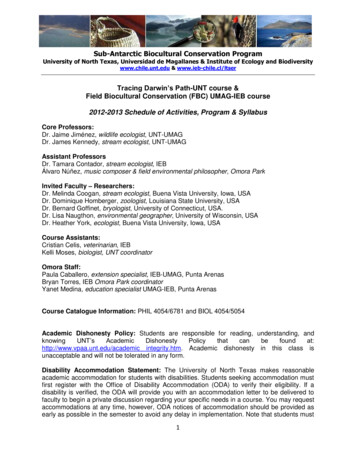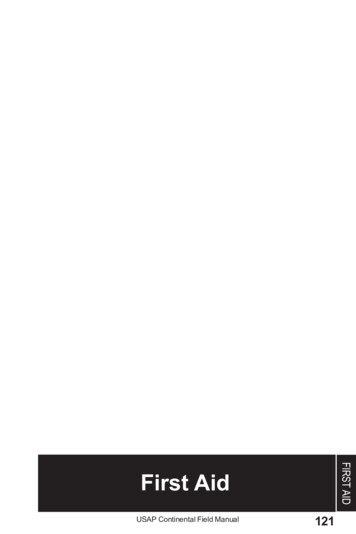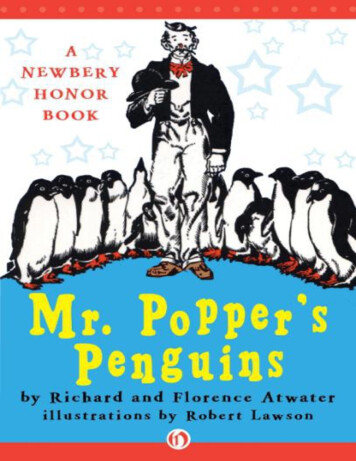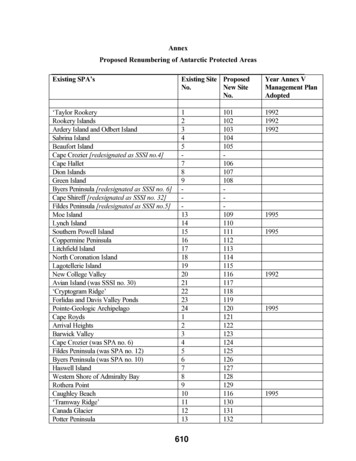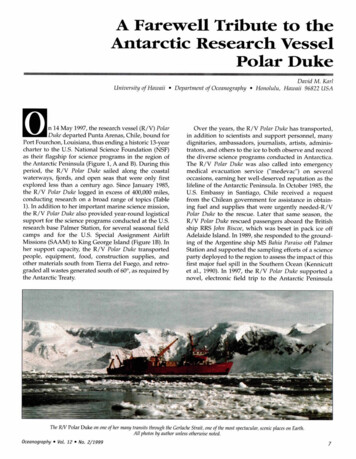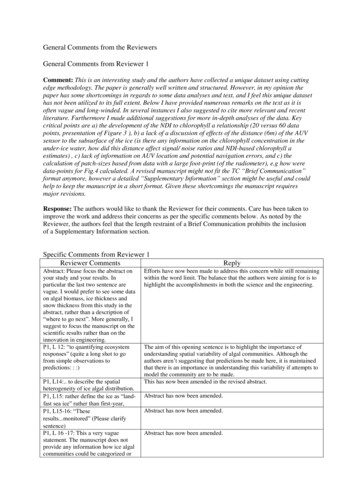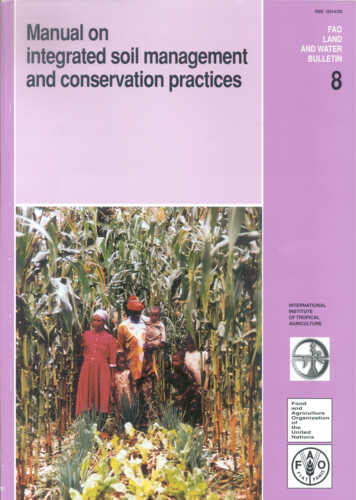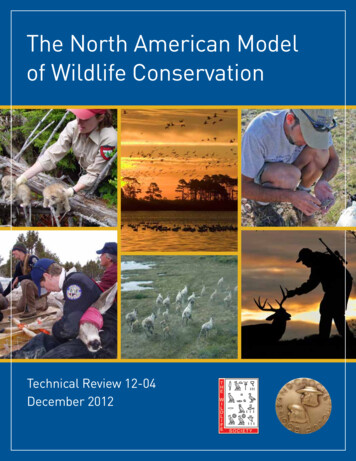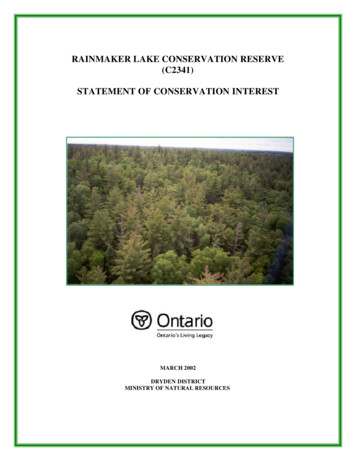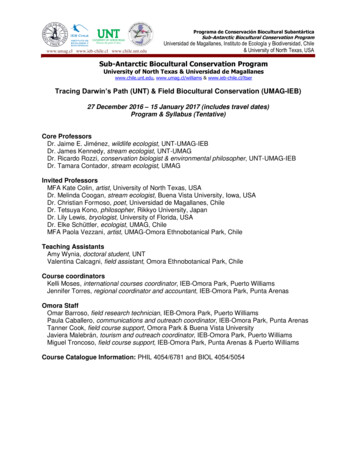
Transcription
Programa de Conservación Biocultural SubantárticaSub-Antarctic Biocultural Conservation Programwww.umag.cl www.ieb-chile.cl www.chile.unt.eduUniversidad de Magallanes, Instituto de Ecología y Biodiversidad, Chile& University of North Texas, USASub-Antarctic Biocultural Conservation ProgramUniversity of North Texas & Universidad de Magallaneswww.chile.unt.edu, www.umag.cl/williams & www.ieb-chile.cl/ltserTracing Darwin’s Path (UNT) & Field Biocultural Conservation (UMAG-IEB)27 December 2016 – 15 January 2017 (includes travel dates)Program & Syllabus (Tentative)Core ProfessorsDr. Jaime E. Jiménez, wildlife ecologist, UNT-UMAG-IEBDr. James Kennedy, stream ecologist, UNT-UMAGDr. Ricardo Rozzi, conservation biologist & environmental philosopher, UNT-UMAG-IEBDr. Tamara Contador, stream ecologist, UMAGInvited ProfessorsMFA Kate Colin, artist, University of North Texas, USADr. Melinda Coogan, stream ecologist, Buena Vista University, Iowa, USADr. Christian Formoso, poet, Universidad de Magallanes, ChileDr. Tetsuya Kono, philosopher, Rikkyo University, JapanDr. Lily Lewis, bryologist, University of Florida, USADr. Elke Schüttler, ecologist, UMAG, ChileMFA Paola Vezzani, artist, UMAG-Omora Ethnobotanical Park, ChileTeaching AssistantsAmy Wynia, doctoral student, UNTValentina Calcagni, field assistant, Omora Ethnobotanical Park, ChileCourse coordinatorsKelli Moses, international courses coordinator, IEB-Omora Park, Puerto WilliamsJennifer Torres, regional coordinator and accountant, IEB-Omora Park, Punta ArenasOmora StaffOmar Barroso, field research technician, IEB-Omora Park, Puerto WilliamsPaula Caballero, communications and outreach coordinator, IEB-Omora Park, Punta ArenasTanner Cook, field course support, Omora Park & Buena Vista UniversityJaviera Malebrán, tourism and outreach coordinator, IEB-Omora Park, Puerto WilliamsMiguel Troncoso, field course support, IEB-Omora Park, Punta Arenas & Puerto WilliamsCourse Catalogue Information: PHIL 4054/6781 and BIOL 4054/5054
COURSE DESCRIPTION:Overview: The University of North Texas (UNT), study abroad course, Tracing Darwin’s Path(TDP) is part of UNT’s Sub-Antarctic Biocultural Conservation Program (SBCP;www.chile.unt.edu). It is taught in partnership with a masters-level class in conservation, FieldBiocultural Conservation at the University of Magallanes (UMAG), Chile. Both courses are alsotaught as part of the Chilean Long-Term Socio-Ecological Research (LTSER) Network’sprogram of field courses, coordinated by the Institute of Ecology and Biodiversity (IEB; www.iebchile.cl).The Field Biocultural Conservation (FBC), and TDP courses will be held between the 27December 2016 and 15 January 2017 (dates include travel days). Students participating in bothcourses will be involved in the same activities throughout the duration of the courses. Theseactivities involve preparatory tasks prior to the course, post-course activities, and for thoseinterested, continued analysis of data. The goals of the course are to provide students with aninterdisciplinary research, conservation and education experience at one of the most pristinewilderness areas remaining in the world. The course will explore ways of defining, studying,communicating, and conserving biocultural diversity. These goals will be achieved by exposingstudents to a first-hand experience in the Omora Ethnobotanical Park (OEP), a long-termecological study site that serves to link society and development with biodiversity, history, andecosystems in the Cape Horn Biosphere Reserve (CHBR).COURSE GENERAL OBJECTIVES:Biocultural diversity has been defined as the “diversity of life in all its manifestations -biological,cultural, and linguistic- that are interrelated within a complex socio-ecological adaptive system.”Addressing modern day environmental issues requires approaches that take into account thismulti-faceted meaning of diversity. In this context, this course will provide students with aninterdisciplinary research, conservation, and education experience at one of the most pristinewilderness areas remaining in the world. The course will explore ways of defining, studying,communicating, and conserving biocultural diversity. These goals will be achieved by exposingstudents to a first-hand experience using the case study of the creation and implementation ofthe OEP as a long-term ecological study site that serves to link society and development withbiodiversity, history and ecosystems in the CHBR.SPECIFIC OBJECTIVES:1) To study various ways of approximating diversity in its multiple manifestation and scales.2) To observe, describe, and investigate in a philosophically-comparative way, and ecologicallyintegrated way, conspicuous (e.g., birds, mammals) and less conspicuous (e.g., aquaticinvertebrates, non-vascular plants) taxonomic groups.3) To utilize the OEP and the CHBR as concrete examples of integrating environmental ethicsand ecological sciences into biocultural conservation, using the Field EnvironmentalPhilosophy (FEP) approach developed by the SBCP research team.4) Partner students from different cultures along with different academic interests, culturalissues and perspectives to provide the opportunity for an interdisciplinary experience thatintegrates philosophical, ecological, environmental, and conservation issues. Through theseopportunities, students will discover and better understand their roles as global citizens.Instructors will strive to provide a characterization of scientific and philosophical research to helpmake distinctions between these two approaches, as well as identify complementaritiesbetween them.2
Research topics of the TDP-FBC January 2017 courseThe general topic of this course is biocultural conservation. It has a strong field component inwhich students get first-hand encounters with the diversity of people inhabiting the sub-AntarcticMagellanic ecoregion (including handcrafters from the indigenous Yahgan community, teachersfrom local schools, tourist operators, as well as Chilean and Latin American students,researchers, and artists), and explore together the main habitat types (including penguincolonies, watersheds dominated by Nothofagus forests, etc.).This year, the class will participate in three long-term studies designed to better understand theecology of the sub-Antarctic forests of the CHBR (55 ). The activities will include research on:1) The ecology of forest bird species through the long-term bird banding program.2) Human-wildlife conflict: the exotic mammals of Navarino Island.3) Long term studies of the diversity and life history of the water invertebrates.4) Water quality of rivers with different human impacts in the Puerto Williams region.5) Ecotourism and Biocultural Conservation in the Miniature Forests of Cape Horn and plantbiology.These activities will include study sites in OEP and in the Robalo Watershed on NavarinoIsland. A specific schedule of activities is provided in the Tentative Schedule.Birds, Exotic Mammals, Aquatic Invertebrate, and Water Quality Studies and EcotourismHere are some of the questions that will be addressed in the research:Small brown forest birds, the most conspicuous and diverse, but little known vertebratesA) How many species exist and how abundant are they in the forest?B) How long do birds live? What do they eat?C) How are birds affected by habitat disturbances?D) What food is available for birds?There are more exotic than native mammals on the IslandA) Which mammals were here 100 years ago and which are here now?B) How did exotics arrive and become established?C) What are their role or impacts in these ecosystems?D) How can we manage established exotic mammals?Aquatic invertebrates, as a barometer for watershed and long-term climate changeA) What are the life cycles of the major aquatic invertebrates in the rivers of the CHBR?B) How are life cycles of aquatic invertebrates influenced by external factors such astemperature and changes to environmental conditions in the watershed?C) How do aquatic insects link terrestrial and aquatic ecosystems?D) How do aquatic invertebrates change relative to human impacts?Water quality in selected rivers in the vicinity of Puerto WilliamsA) How do key water quality characteristics change along a stream gradient?B) How does water quality change relative to human impacts?Ecotourism and Biocultural ConservationFinally, ornithological, plant, and freshwater ecology work will involve the practice of ecotourismas a tool to achieve biocultural conservation.3
A) Students will be required to take what they have learned from the course and prepareactivities for tourists and other visitors to Omora Park that include an ecological and ethicalorientation.B) Activity approaches will aim for visitors to gain not only an understanding and knowledgeabout the unique sub-Antarctic biodiversity, but also provide a transformative experienceto cultivate an ethical and sustainable relationship with this biodiversity, both locally andglobally. Experience will focus on ecotourism with a hand-lens.C) How do vascular and non-vascular plant diversty contrast in lower and higher elevations atOmora Park? How can the little non-vascular plants be included in ecotourism? How canyou communicate the ecological, economic, aesthetic, and ethical values of bryophytes?GradingPre-course assignments(1) Comparison and Description of Avian Inhabitants/Habitats/Habits of Cape Horn and ofHigh Northern Latitudes of the Americas (10%)Each participant should use the provided list of birds to do a complete worksheet and addpictures and descriptions of each species regarding morphological characteristics, habitatrequirements, behavior, diet, or other relevant habits and information. This exercise will help youprepare by way of comparison and analogy to understand new organisms based on theirrelationship, similarities, and differences to other species you know. To receive credit, thecompleted assignment should be submitted by email (Jaime.Jimenez@unt.edu) no later than5:00 PM on December 26th, 2016.(2) Description of the climate and freshwater (10%)Each student, using the readings (particularly useful will be Hynes 1975 and Vannote et al.1979), will be required to write a narrative describing the changes they expect to observe andmeasure in the Robalo River watershed from the headwaters to the river’s mouth. The papershould also contrast annual climatic conditions in the Cape Horn region to those seen at similarlatitude in the Northern Hemisphere. To receive credit, the completed assignment should besubmitted by email (James.Kennedy@unt.edu) no later than 5:00 PM on December 26th, 2016.In-course assignment and evaluations(3) Ecotourism with a Hand Lens in the Miniature Forests of Cape Horn (10%)Students will gain a general overview of bryology and identify mosses, liverworts, and lichens ondifferent substrates (bark, soil, rock) and their ecological interactions with other plants, animals,and ecosystem functions. Students will also clearly define economic, aesthetic, ecological, andethical values of bryophytes and biodiversity in general. They will integrate this understandingwith the metaphor of the hand lens and the activity of ecotourism with a hand lens, designingtheir own way of guiding this activity. This will prepare for practicing the biocultural conservationapproach to promote the integration of ecological sciences and environmental ethics, and theconservation of the tiny plants and animals inhabiting the Miniature Forests of Cape Horn thatso often are overlooked in traditional conservation initiatives. This activity will be assigned andgraded during the course.(4) Natural History / Art Journal (15%)When reading Charles Darwin’s journal Voyage of the Beagle about his 5-year trip around theworld, it is striking the way he blends scientific observation with reflections about the broaderimplications, context, and surroundings (including cultures) he was encountering. Otherexamples include Lewis and Clark’s writings about the Western United States. We would like to4
“trace Darwin’s path” and ask each student to keep a journal of the day’s reading, reflections,activities, and achievements. Entries should consist of reflections on the assigned readingsand/or activities and observations made during field activities. Ideally, field notes will be madeusing a waterproof pen (or pencil) in a journal with waterproof paper (such as Rite in the Rain,All-Weather Journal). However, other notebooks can be used but they must be bound andshould be protected in a sealable plastic bag. Maximum size for the field notebook should beapproximately 8.5" x 11" when two pages are open. This size will enable the journal to bexeroxed conveniently and also to carry in the field, which will be necessary, since recordings injournals are to be done on the day of the activities. In addition, an art notebook (can be thesame notebook as above) will be needed with the same dimensions, but ensuring a hard coverand 180 to 240 weight paper that allows for drawing. Other art materials will be provided inChile. Student journals will be checked randomly throughout the course. Suggestions will bemade on improving the quality of the journal format. It will be expected that journal entries are,as reasonably as possible, kept up to date, legible, and well organized. This document will bekey to keep your valuable records, thoughts, and experiences while in the field and may servefor your future purposes. At the end of the class, journals will be collected on January 12th,2017, and may be copied before being returned to the student.(5) Guided Field Activities (15%)The course participants will conduct a guided tour for scientists and other visitors to Omora Parkon January 6th. The goal of this “tour” is for students to learn the Omora Park’s existing trailsystems and interpretive content, as well as synthesize their own experiences into simplenarratives. As much as possible, the work groups will be structured to represent a cross sectionof academic interests of the course participants. This activity will be assigned and graded duringthe course.(6) Participation (15%) & Presentation of Research Results (15%)A list of mandatory, suggested, and supplemental readings is provided in the section followingthe list of activities. Student responsibilities are to prepare ahead of time, attend all thediscussion sessions, field exercises, ask questions, and express themselves creatively andconcisely in their work. Ways of earning points for participation include contributing positively toclass discussion of readings and participate in field exercises. Contributing positively requireshaving read, and as thoroughly as possible understood, the assigned readings and at leastbeing able to raise important questions if not providing definitive answers. Students will alsoprepare PowerPoint presentations after samples have been analyzed in order to presentpreliminary results. These presentations will be carried out during January 12th, 2017 at theField Station.Post-course assignment(7) Essay (10%)Each student will select one of the class topics (see above) and using the readings, develop a5-7 page (12 font, double spaced) essay summarizing that theme of the course with an endingdiscussion. To receive credit, essays should be submitted by email no later than 5:00 PM onFebruary 28th 2017.5
UNIVERSITY OBLIGATIONS AND POLICIESBEHAVIORStudy abroad trips require considerable flexibility, maturity, and cultural sensitivity. The culture and thepolitical system you will be exposed to in this class will be different than the US and may provoke strongemotional responses. We expect that you will strive to understand the culture and learn to reason throughany uncomfortable, but productive, experiences.HEALTH, SAFETY, LEGAL ISSUES ABROADUNT’s study abroad program will provide guidance regarding legal issues associated with travel to Chile.They will also provide travel health insurance information via the study abroad application link.Academic Dishonesty Policy: Students are responsible for reading, understanding, and knowing UNT’sAcademic Dishonesty Policy that can be found at: http://www.vpaa.unt.edu/academic integrity.htm.Academic dishonesty in this class is unacceptable and will not be tolerated in any form.Disability Accommodation Statement: The University of North Texas makes reasonable academicaccommodation for students with disabilities. Students seeking accommodation must first register with theOffice of Disability Accommodation (ODA) to verify their eligibility. If a disability is verified, the ODA willprovide you with an accommodation letter to be delivered to faculty to begin a private discussionregarding your specific needs in a course. You may request accommodations at any time, however, ODAnotices of accommodation should be provided as early as possible in the semester to avoid any delay inimplementation. Note that students must obtain a new letter of accommodation for every semester andmust meet with each faculty member prior to implementation in each class. Students are stronglyencouraged to deliver letters of accommodation during faculty office hours or by appointment. Facultymembers have the authority to ask students to discuss such letters during their designated office hours toprotect the privacy of the student. For additional information see the Office of Disability Accommodationwebsite at http://www.unt.edu/oda. You may also contact them by phone at 940.565.4323.Drop/Withdrawal Information: Drop/Withdrawal Information and other important Academic Dates can befound at htmlREADINGSMost readings can be found on-line and downloaded as PDFs documents from:UNT library site (UNT student credentials required; Password: chile2017)http://guides.library.unt.edu/c.php?g 415168&p 2828887UMAG-Omora site (Password: /?page id 4212Required TextbooksGoffinet, B., R. Rozzi, L. Lewis, W. Buck & F. Massardo. 2012. The Miniature Forests of Cape Horn: EcoTourism with a Hand-lens (“Los Bosques en Miniatura del Cabo de Hornos: Ecoturismo conLupa”). Bilingual English-Spanish edition. UNT Press-Ediciones Universidad de Magallanes,Denton, TX and Punta Arenas, Chile. 448 pp. ISBN 978-1-57441-282-6.Rozzi, R. & J.E. Jiménez (eds.). 2014. Magellanic Sub-Antarctic Ornithology. First decade of long-termbird studies at the Omora Ethnobotanical Park, Cape Horn Biosphere Reserve, Chile. Universityof North Texas Press-Universidad de Magallanes, Denton, TX and Punta Arenas, Chile. 364 pp.ISBN-13: 978-1-57441-531-5.6
Rozzi, R., F. Massardo, C. Anderson, S. McGehee, G. Clark, G. Egli, E. Ramilo, U. Calderón, C.Calderón, L. Aillapan & C. Zárraga. 2010a. Multi-Ethnic Bird Guide of the Sub-Antarctic Forests ofSouth America. University of North Texas Press-Ediciones Universidad de Magallanes, Denton,TX and Punta Arenas, Chile. 235 pp. ISBN-13: 978-57441-282-6.Required ReadingsContador, T.A., J.H. Kennedy, R. Rozzi & J. Ojeda. 2015. Sharp altitudinal gradients in Magellanic subAntarctic streams: patterns along a fluvial system in the Cape Horn Biosphere Reserve (55oS).Polar Biology DOI 10.1007/s00300-015-1746-4Darwin, C. 1838. Tierra del Fuego. Pp. 204-231, in The Voyage of the Beagle. Reprint, London:Everyman’s Library, 1975.Elphick, C.S., J.E. Jiménez, R. Reyes & R. Rozzi. 2014. Seasonal dynamics of the Sub-Antarctic birdcommunity in different habitats of the Cape Horn Biosphere Reserve. Introduction to Section 2,pp. 185-187, in Rozzi, R. & J.E. Jiménez (eds.), Sub-Antarctic Magellanic Ornithology, FirstDecade of Bird Studies at Omora Ethnobotanical Park: Cape Horn Biosphere Reserve. UNTPress-Ediciones Universidad de Magallanes, Denton TX, USA - Punta Arenas, Chile.Hynes, H.B.N. 1975. The stream and its valley. Edgardo Baldi Memorial Lecture. Verhandlungen desInternationalen Verein Limnologie 19: 1-15.Ippi, S., C. Anderson, R. Rozzi & C. Elphick. 2009. Annual variation of abundance and composition inforest bird as assemblages on Navarino Island, Cape Horn Biosphere Reserve, Chile. OrnitologíaNeotropical 20: 231-245Leopold, A. 1949. Foreword (pp. vii-ix), 65290 (pp. 87-92), Thinking like a Mountain (pp. 129-133), TheLand Ethic (pp. 201-226), in A Sand County Almanac and sketches here and there. OxfordUniversity Press, New York.Miller, K.K., E.G. Ritchie & M.A. Weston. 2014. The human dimensions of dog-wildlife interactions. Pp.286-303, in M.E. Gompper (ed.), Free-ranging dogs & wildlife conservation. Oxford UniversityPress, Oxofrd, U.K.Ojeda, J., T. Contador, S. Rosenfeld, C.B. Anderson, A. Mansilla & J. Kennedy. 2010. Guía para laidentificación de los invertebrados marinos y dulceacuícolas de la Reserva de Biosfera Cabo deHornos. Ed. Universidad de Magallanes, Punta Arenas.Ralph, C.J. 2005. The body grasp technique: a rapid method of removing birds from mist nets. NorthAmerican Bird Bander Apr-Jun: 65-70.Rozzi, R., X. Arango, F. Massardo, C. Anderson, K. Heidinger & K. Moses. 2008a. Field EnvironmentalPhilosophy and Biocultural Conservation: The Omora Ethnobotanical Park Educational Program.Environmental Ethics 30: 325-336.Rozzi, R., C. Anderson, C. Pizarro, F. Massardo, Y. Medina, A. Mansilla, J. Kennedy, et al. 2010b. Fieldenvironmental philosophy and biocultural conservation at the Omora Ethnobotanical Park:Methodological approaches to broaden the ways of integrating the social component (“S”) inLong-Term Socio-Ecological Research (LTSER) Sites. Revista Chilena de Historia Natural 83:SM19-SM28 (27-68).Steinbeck, J. & E.F. Ricketts. 1941. Sea of Cortez: A Leisurely Journal of Travel and Research. VikingPress. Chapters 4 and 21.Sutherland, W.J. 2003. Parallel extinction risk and global distribution of languages and species. Nature423: 276-279.Vannote, R.L., G.W. Minshall, K.W. Cummins, J.R. Sedell & C.E. Cushing. 1980. The river continuumconcept. Canadian Journal Fisheries and Aquatic Sciences 37: 130-137.White, L., Jr. 1967. The historical roots of our ecological crisis. Science 155: 1203-1207.Supplementary TextbooksContador, T.A. & J.H. Kennedy. 2014. Habitantes sumergidos bajo los ríos del Cabo deHornos/Underwater inhabitants of the rivers of Cape Horn. Ediciones Universidad de Magallanes,Punta Arenas, Chile. 96 pp. ISBN: 978-956- 358-063-1Jaramillo, A. 2003. Birds of Chile. Princeton University Press, Princeton.Rozzi, R., L. Lewis, F. Massardo, Y. Medina, K. Moses, M. Méndez, L. Sancho, P. Vezzani, S. Russell &B. Goffinet. 2012a. Ecotourism with a Hand-Lens at Omora Park. It includes the docummentary7
“The Invisible Journey” by Jaime Sepúlveda, and photography by Adam Wilson. EdicionesUniversidad de Magallanes, Punta Arenas, Chile. (190 pp.) ISBN 978-956-9160-00-4.Supplementary ReadingsAnderson, C.B., R. Rozzi, J.C. Torres-Mura, S.M. McGehee, M.F. Sherriffs, E. Schüttler & A.D.Rosemond. 2006. Exotic vertebrate fauna in the remote and pristine sub-Antarctic Cape HornArchipelago, Chile. Biodiversity and Conservation 15: 3295-3313.Bonnet, X., R. Shine & O. Lourdais. 2002. Taxinomic chauvinism. Trends in Ecology and Evolution 17:13.Contador, T.A., J. Kennedy & R. Rozzi. 2012. The conservation status of southern South Americanaquatic insects in the literature. Biodiversity and Conservation 21: 2095-2107.Contador, T., J. Kennedy, J. Ojeda, P. Feinsinger & R. Rozzi. 2014. Ciclos de vida de insectosdulceacuícolas y cambio climático global en la ecorregión subantártica de Magallanes:investigaciones ecológicas a largo plazo en el Parque Etnobotánico Omora, Reserva de BiosferaCabo de Hornos (55 S). Bosque 34: 429-437.Crego, R.D., J.E. Jiménez & R. Rozzi. 2016. A synergic trio of invasive mammals? Facilitativeinteractions among beavers, muskrats, and mink at the southern end of the Americas. BiologicalInvasions 18:1923-1938. DOI 10.1007/s10530-016-1135-0Darwin, C. 1838. The Voyage of the Beagle. Reprint, London: Everyman’s Library, 1975.Jiménez, J.E., R. Crego, G.E. Soto, I. Román, R. Rozzi & P.M. Vergara. 2014. Potential impact of thealien American mink (Neovison vison) on Magellanic woodpeckers (Campephilus magellanicus)in Navarino Island, southern Chile. Biological Invasions 16: 961-966.Jiménez, J.E., A.E. Jahn, R. Rozzi & N.E. Seavy. 2016. First documented migration of individual Whitecrested Elaenias (Elaenia albiceps chilensis) in South America. Wilson Journal of Ornithology128: 413-419.Leopold, A. 1949. A Sand County Almanac and sketches here and there. Oxford University Press, NewYork.McEwan, C., L.A. Borrero & A. Prieto (eds.). 1997. Excerpts from Patagonia: Natural History, Prehistoryand Ethnography at the Uttermost End of the Earth, Princeton University Press.Naess, A. 1973. The shallow and the deep, long-range ecology movements. Inquiry 16: 95-100.Pyle, P., S.N. Howell, R.P. Yunick & D.F. DeSante. 1987. Identification guide to North AmericanPasserines. Slate Creek Press, Bolinas, California.Rozzi, R. & F. Massardo. 2011. The road to biocultural ethics. Frontiers in Ecology 9: 246-247.Rozzi, R., F. Massardo, C. Anderson, K. Heidinger & J. Silander, Jr. 2006. Ten principles for bioculturalconservation at the southern tip of the Americas: The Approach of the Omora EthnobotanicalPark. Ecology & Society 11(1): 43. [online] t43/Rozzi, R., J.J. Armesto, B. Goffinet, W. Buck., F. Massardo, J. Silander, Jr., M.T.K. Arroyo, S. Russell,C.B. Anderson, L.A. Cavieres, & J.B. Callicott. 2008b. Changing lenses to assess biodiversity:patterns of species richness in sub-Antarctic plants and implications for global conservation.Frontiers in Ecology 6: 131-137.Rozzi, R., J. Armesto, J. Gutierrez, C. Anderson, F. Massardo, G. Likens, A. Poole, K. Moses, E.Hargrove, A. Mansilla, J. Kennedy, M. Willson, K. Jax, C. Jones, J.B. Callicott & M. Arroyo.2012b. Integrating ecology and environmental ethics: Earth stewardship in the southern end ofthe Americas. BioScience 62: 226-236.Schüttler, E., R. Rozzi & K. Jax. 2011. Towards a societal discourse on invasive species management: Acase study of public perceptions of mink and beavers in Cape Horn. Journal for NatureConservation 19: 175-184.Vuilleumier, F. 1985. Forest birds of Patagonia: Ecological geography, speciation, endemism and faunalhistory. Ornithological Monographs 36: 255-304.8
Programa de Conservación Biocultural SubantárticaSub-Antarctic Biocultural Conservation Programwww.umag.cl www.ieb-chile.cl www.chile.unt.eduUniversidad de Magallanes, Instituto de Ecología y Biodiversidad, Chile& University of North Texas, USATentative Schedule and ActivitiesTRACING DARWIN’S PATH:Field Biocultural Conservation (Conservacion Biocultural de Campo)Course Dates: 28 December 2015 - 14 January 2016Travel Dates: 27 December & 15 JanuaryOn days when multiple activities are scheduled course participants will be divided into smallergroups that will rotate through all of the laboratory and field activities. Please note that thisschedule is tentative. Weather or other events beyond the instructors’ and/or coordinators’control may require changes to the schedule.27 Tuesday28 Wed.Departs U.S. (on individual itineraries)Morning:Afternoon:6:30 pm:9:55 pm:Arrive to Santiago (individual itineraries)Movie: “The Invisible Journey” in airportDepart Santiago to Punta Arenas (LAN LA283)Arrive to Punta ArenasBus to Hostal Hain11:00 pm: Dinner at Hostel HainUnit 1: Introduction to the Region and Course Topics & Ecotourism with a Hand-Lens (EHL)UNT & Japan – Professors: R. Rozzi, K.Collin, C. Formoso, T. Kono29 Thursday 7:30 am:Breakfast at Hostal Hain9:00 am:Depart to Reserva deMagallanes Introduction to relevant coursetopics (R. Rozzi) Taxonomic Chauvinism andEcotourism with a Hand Lens(R. Rozzi & graduate students)Readings: Rozzi et al. 2008a: 325-33011:30 am: Bus to Instituto de laBVU, UMAG & IEB – Professors: J.Kennedy, J. Jiménez, M. Coogan,S. Hayes7:30 am:Breakfast at Hostal Hain9:00 am:Depart to Reserva deMagallanes Introduction to relevant coursetopics (R. Rozzi) Taxonomic Chauvinism andEcotourism with a Hand Lens(R. Rozzi & graduate students)Readings: Rozzi et al. 2008a: 325-33011:30 am: Bus to Instituto de la
Patagonia12:00 pm: Box lunch at the botanicalgarden, Sub-Antarctic BioculturalConservation Program Office13:00 pm: Bus to Cemetery The most beautiful cemetery (C.Formoso)3:00 pm (TBA): Bus to Tres Puentes toboard Ferry30 FridayNavigating through the northwest armof the Beagle ChannelReadings: Darwin (1838): 204-2312:00 pm (TBA): Lecture: “Garden asrepresentation of the Universe” (T.Kono)11:59 pm: Arrival & check-in to HostalPatagonia12:00 pm: Box lunch at the botanicalgarden, Sub-Antarctic BioculturalConservation Program Office13:00 pm: Bus to Cemetery The most beautiful cemetery (C.Formoso)3:00 pm: Depart by ferry to penguincolony on Magdelena Island Biocultural Conservation (J.Kennedy)Readings: Rozzi et al. 2008a: 325-3308:30 pm: Dinner (TBD)8:00 am:Breakfast at Hostal Hain 9:30 am: Transport to airport (TBC) 12:00 pm: Fly to Puerto Williams 1:00 pm: Arrive in Puerto Williamsand check-in to Hostal31 Saturday 8:00 am:Breakfast at hostal9:00 am:Walk to Omora Ethnobotanical Park (OEP)10:00 am: OEP visit & 1st Session on Field Environmental Philosophy (FEP)(L. Lewis, R. Rozzi)12:00 pm: Lunch at OEP1:00 pm: Closing OEP visit & 1st Session on Field Environmental Philosophy(L. Lewis, R. Rozzi)2:00pm:Transporation to Handicraft Workshop site for Handicraft workshop(J. Gonzalez & T. Contador)Readings: Sutherland 20037:00 pmWalk to Laguna Zañartu8:30 pm: New Year’s Patagonian lamb barbecue at Laguna Zañartu (or RobaloBay, weather permitting)01 Sunday 9:30 am:1:00 pm:3:00 pm:Breakfast at Hostal ForjadoresFree timeLunch at Cape Horn Field Station (CHFS)Field drawing and journaling experience in the field (K. Colin, C.Formoso)2
6:00 pm: Movies: “La Ultima Huella (The Last Trace)” and “Hanis Lush”7:30-9:30 pm: Dinner at CHFS 7:30-8:15 pm: Dinner Group A 8:30-9:15 pm
Overview: The University of North Texas (UNT), study abroad course, Tracing Darwin's Path (TDP) is part of UNT's Sub-Antarctic Biocultural Conservation Program (SBCP; www.chile.unt.edu). It is taught in partnership with a masters-level class in conservation, Field Biocultural Conservation at the University of Magallanes (UMAG), Chile.
